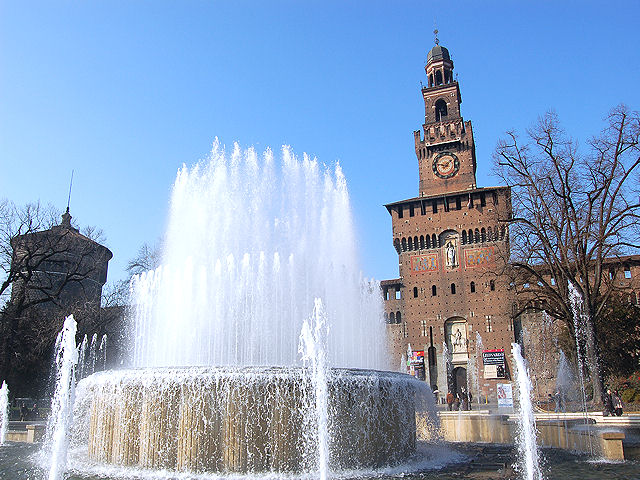
Fountain in front of the Torre del Filarete. In the main entrance to the Ducal Courtyard museums is a stairway leading to the Rocchetta first and second floors, which house the Sforzesco Castle Applied art collections. On the first floor is the so-called Sala della Balla, where ladies and knights at the Sforza Court used to amuse themselves. Here are the magnificent Trivulzio Tapestries, manufactured in Vigevano according to Bramantino's cartoons. In the ball room are also some of the exhibits belonging to the museum of musical instruments. The collection was acquired by the city of Milan starting from the '50s with the Gallini Collection, but includes also a wide range of other exhibits, in particular stringed instruments from Lombardy. In the following rooms are 16th and 17th century lutes, arch lutes, zithers, guitars, and strings that made families from Cremona (the Amati and the Guarneri) renowned in the 17th century. The wind instruments deserve great attention too, to begin with the old hunting horns, the numerous wood instruments (e.g. flutes, oboes, clarinets, English horns) and the bassoons. There are also many valuable exhibits, such as Mango Longo's ten-string guitar, a 16th century harpsichord of the Venice school, Johannes Maria Anciuti's oboe (1722) and a rare glass harmonica, which had once belonged to Pietro Verri. Not to be forgotten, a section with a collection of non-European instruments and two rooms (room XXXIV and room XXXV) with a collection of instruments donated to the castle museum by the Antonio Monzino Foundation in 2000. On the second floor of the Rocchetta is exhibited a great variety of decorative arts from Lombardy, including artistic ceramics, antique furniture, ivories dating from the 4th to the 18th centuries, enamelware from Limoges scientific instruments and time meters. Among the ivory, the consul's diptychs and the Trivulzio little plate, on which emperor Ottone's family is portrayed, deserve particular attention, among the jewellery, Voghera's monstrance must be mentioned. There are interesting wrought iron exhibits, as well as glassware, majolica and china, put in chronological order, from the Middle Ages until the 19th century. Some works are by great majolica painters of the Renaissance - e.g. Francesco Xanto Avelli and Nicola da Urbino - some other by the most important china factories of the 18th century in Europe - e.g. Meissen, Vienna, Capodimonte and Ginori of Doccia.